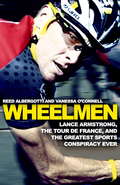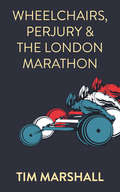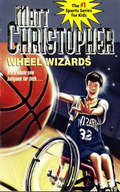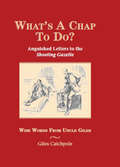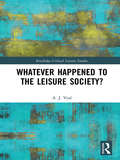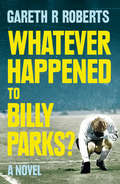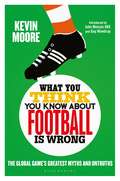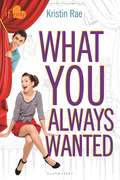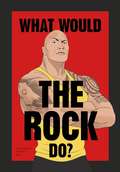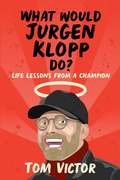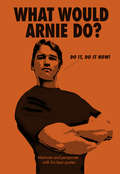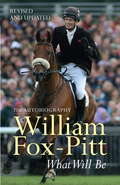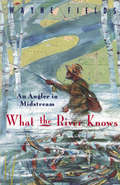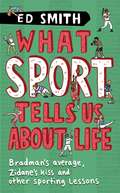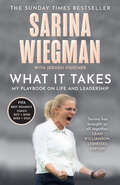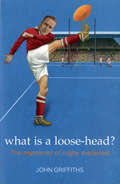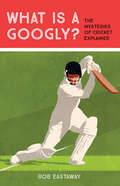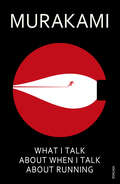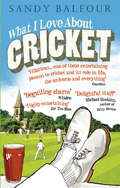- Table View
- List View
Wheelmen: Lance Armstrong, The Tour De France, And The Greatest Sports Conspiracy Ever
by Vanessa O'Connell Reed AlbergottiWith a new Afterword.Lance Armstrong won a record-smashing seven Tour de France yellow jerseys after staring down cancer, and in the process became an international symbol of resilience and courage. In a sport constantly dogged by blood doping scandals, Armstrong seemed above the fray. Never had cycling - or any sport-boasted such a charismatic and accomplished champion. Then, in the summer of 2012, the legend imploded. The rumors that had long dogged Armstrong began to solidify. Buried evidence surfaced. Hushed-up witnesses came forth. Armstrong's Tour victories were stripped from him. His sponsors abandoned him. In January 2013, Armstrong finally admitted doping during the Tours, and in an interview with Oprah, described his "mythic, perfect story" as "one big lie." But his admission raised more questions than it answered. With over three years of extensive reporting, deep sourcing, and interviews with nearly every key player, including Armstrong, Reed Albergotti and Vanessa O'Connell have established themselves as the undisputed authorities on this story. Wheelmen reveals the broader tale of how Armstrong and his supporters used money, power, and cutting-edge science to conquer the world's most difficult race. It offers a riveting look at what happens when enigmatic genius breaks loose from the strictures of morality. It reveals the competitiveness and ingenuity that sparked blood doping as an accepted practice, and shows how Americans methodically constructed an international operation of spies and breakthrough technology to reach the top. Lance Armstrong survived and thrived against nigh-insurmountable odds and built a team of unprecedented accomplishment. But in the end, his own outsized ambition destroyed it. At last exposing the truth about Armstrong and American cycling, Wheelmen paints a living portrait of what is, without question, the greatest conspiracy in the history of sports.
Wheelchairs, Perjury and the London Marathon
by Tim MarshallThe top wheelchair athletes of today enjoy the same high-profile exposure and admiration as their able-bodied counterparts. This has come about partly through wheelchair participation in mass fun-running events such as the Great North Run. Wheelchairs, Perjury and the London Marathon charts disability sports pioneer Tim Marshall MBE’s journey from the rock-climbing accident which left him paralysed, to becoming a trailblazer for wheelchair racing. The fun-runs of the 1980s enabled wheelchair road-racing to flourish, and Marshall took part in marathons and half-marathons where wheelchairs were welcome to compete. This did not, however, include The London Marathon, from which wheelchairs were banned for the first two years. This is the story of how this prohibition was overturned, told from the competitor’s point of view. Tim and many others campaigned for the inclusion of wheelchairs in The London Marathon in the face of huge opposition from the organisers. Finally, in 1983 the efforts of sportsmen and women, the press, the Greater London Council and members of parliament resulted in a breakthrough just ten days before the 1983 marathon, which at last agreed to wheelchair participation. Wheelchairs, Perjury and the London Marathon reveals the tenacity and resolve required to achieving sporting greatness in the face of adversity. Tim Marshall’s story — and the legacy he has helped build for disabled sports — are a testament to his love of racing and his passion for disability equality.
Wheelchair table tennis (UEB Uncontracted)
by Rnib BookshareOn this page, there is a table tennis bat (paddle or racquet) seen from the front and the side, and two players taking part in a match. Each image has a dashed line image border. There is a locator dot shown, which will be at the top left of the page when the image is the right way up. Table tennis bat front view (top left) This is an image of a table tennis bat seen from the front. To the top left of the image is the oval-shaped head of the bat, and to the bottom right is the handle. Each side of the bat (the front and back) has a layer of sponge covered with a layer of soft, pimpled rubber. Table tennis bat side view (top right) This picture shows a table tennis bat seen from the side, revealing the different layers of material used to make it. The head of the bat is to the left of the image. Nearest the top of the image is the first layer of soft rubber with raised pimples on it. The pimpled side is glued to the sponge layer down the page, so that the outer surface is smooth. Further down is the wooden blade of the bat, another layer of sponge, and another layer of pimpled rubber â " this one facing down so that the pimples are on the outside of the bat. Each player will have preferences for different types of rubber, with pimples on the inside or outside, depending on their style of play. The pimples greatly increase the 'stickiness' of the bat and allow more spin to be applied to the ball. The handle of the bat is to the right of the image. Wheelchair table tennis match (bottom) This is an image of two players and a table tennis table seen from the side.On the left of the image is a player facing right. At the top left is his head and down the page is his body, with an arm extending to the right. He is holding a bat in his hand. His body goes down the page to a wheelchair, which has a large wheel to the left and a small wheel to the right, close to the floor at the bottom of the page. One leg can be found to the right of his body, extending to the right and down. The ball can be found to the right of the bat, flying through the air. The table stretches across the page to the player on the right. It has a leg on each side and one in the middle. The net is in the centre of the table, to the right of the ball. The player on the right is facing left, with his head to the top right of the image. His body is down the page; his arm with his hand holding a bat is to the left of this. He has another arm, which has been amputated at the elbow, just down from his head. Further down is part of his leg and down again the wheelchair can be found, with a small wheel to the left and a large wheel to the right.
Wheelchair table tennis (UEB Contracted)
by Rnib BookshareOn this page, there is a table tennis bat (paddle or racquet) seen from the front and the side, and two players taking part in a match. Each image has a dashed line image border. There is a locator dot shown, which will be at the top left of the page when the image is the right way up. Table tennis bat front view (top left) This is an image of a table tennis bat seen from the front. To the top left of the image is the oval-shaped head of the bat, and to the bottom right is the handle. Each side of the bat (the front and back) has a layer of sponge covered with a layer of soft, pimpled rubber. Table tennis bat side view (top right) This picture shows a table tennis bat seen from the side, revealing the different layers of material used to make it. The head of the bat is to the left of the image. Nearest the top of the image is the first layer of soft rubber with raised pimples on it. The pimpled side is glued to the sponge layer down the page, so that the outer surface is smooth. Further down is the wooden blade of the bat, another layer of sponge, and another layer of pimpled rubber â " this one facing down so that the pimples are on the outside of the bat. Each player will have preferences for different types of rubber, with pimples on the inside or outside, depending on their style of play. The pimples greatly increase the 'stickiness' of the bat and allow more spin to be applied to the ball. The handle of the bat is to the right of the image. Wheelchair table tennis match (bottom) This is an image of two players and a table tennis table seen from the side.On the left of the image is a player facing right. At the top left is his head and down the page is his body, with an arm extending to the right. He is holding a bat in his hand. His body goes down the page to a wheelchair, which has a large wheel to the left and a small wheel to the right, close to the floor at the bottom of the page. One leg can be found to the right of his body, extending to the right and down. The ball can be found to the right of the bat, flying through the air. The table stretches across the page to the player on the right. It has a leg on each side and one in the middle. The net is in the centre of the table, to the right of the ball. The player on the right is facing left, with his head to the top right of the image. His body is down the page; his arm with his hand holding a bat is to the left of this. He has another arm, which has been amputated at the elbow, just down from his head. Further down is part of his leg and down again the wheelchair can be found, with a small wheel to the left and a large wheel to the right.
Wheelchair table tennis (Large Print)
by Rnib BookshareOn this page, there is a table tennis bat (paddle or racquet) seen from the front and the side, and two players taking part in a match. Each image has a dashed line image border. There is a locator dot shown, which will be at the top left of the page when the image is the right way up. Table tennis bat front view (top left) This is an image of a table tennis bat seen from the front. To the top left of the image is the oval-shaped head of the bat, and to the bottom right is the handle. Each side of the bat (the front and back) has a layer of sponge covered with a layer of soft, pimpled rubber. Table tennis bat side view (top right) This picture shows a table tennis bat seen from the side, revealing the different layers of material used to make it. The head of the bat is to the left of the image. Nearest the top of the image is the first layer of soft rubber with raised pimples on it. The pimpled side is glued to the sponge layer down the page, so that the outer surface is smooth. Further down is the wooden blade of the bat, another layer of sponge, and another layer of pimpled rubber â " this one facing down so that the pimples are on the outside of the bat. Each player will have preferences for different types of rubber, with pimples on the inside or outside, depending on their style of play. The pimples greatly increase the 'stickiness' of the bat and allow more spin to be applied to the ball. The handle of the bat is to the right of the image. Wheelchair table tennis match (bottom) This is an image of two players and a table tennis table seen from the side.On the left of the image is a player facing right. At the top left is his head and down the page is his body, with an arm extending to the right. He is holding a bat in his hand. His body goes down the page to a wheelchair, which has a large wheel to the left and a small wheel to the right, close to the floor at the bottom of the page. One leg can be found to the right of his body, extending to the right and down. The ball can be found to the right of the bat, flying through the air. The table stretches across the page to the player on the right. It has a leg on each side and one in the middle. The net is in the centre of the table, to the right of the ball. The player on the right is facing left, with his head to the top right of the image. His body is down the page; his arm with his hand holding a bat is to the left of this. He has another arm, which has been amputated at the elbow, just down from his head. Further down is part of his leg and down again the wheelchair can be found, with a small wheel to the left and a large wheel to the right.
Wheel Wizards: It's a whole new ballgame for Seth...
by Matt ChristopherTwelve-year-old Seth Pender thinks his life came to an end when he suffered a spinal injury that left him confined to a wheelchair. Seth, an athlete who loves basketball, is sure he'll never play again. He grows sullen and silent, unresponsive when his family urges him to try to adjust. Then one day he sees an older boy who, like himself, is wheelchair bound. But this boy is playing basketball! How is that possible? Over the course of three years, Seth (and the reader) learns about the sport of wheelchair basketball: the similarities and differences between it and regular basketball, the skills one needs to excel at it, and the camaraderie that grows amongst the players. By the end of the story, Seth is better adjusted to his life, and ready to reach out a hand to help others find their way.
What's A Chap To Do?: Anguished Letters To The Shooting Gazette
by Giles CatchpoleThere are many excellent books to advise the novice shooter on proper gun handling, safety and accuracy. However, no manual can hope to address every problem that might arise in the shooting field or, indeed, beyond it. Being British, there are many such issues which we would never dream of mentioning, let alone actually discussing. A pursed lip or a raised eyebrow may be as far as many chaps are prepared to go in addressing some of these important matters. But these gestures are open to misinterpretation and misunderstanding with possibly disastrous consequences. A few words of advice, a reassuring hand on the shoulder, that just puts a chap's mind at rest and sets him comfortably back on the straight and narrow. Uncle Giles is such a chap and his wise words have been clarifying these matters for readers of the Shooting Gazette for a number of years. A selection of these concerns - and their resolution - are now shared with a wider public.
Whatever Happened to the Leisure Society? (Routledge Critical Leisure Studies)
by A. J. VealThe idea of a ‘leisure society’ was in its heyday in the 1960s and 1970s, when it was predicted that the pattern of falling working hours which had been experienced in Western societies in the first half of the twentieth century would continue indefinitely. The leisure society has clearly not been realised. On the contrary: contemporary industrial societies seem to be characterised by a shortage of time, experienced as ‘time squeeze’ and stress. The leisure society idea can be seen as the modern version of the age-old dream of a ‘life of ease and plenty’. This analytically and empirically rich book traces the idea in history, through biblical, classical Greek, medieval and nineteenth century utopian writings and into twentieth century concerns with dystopia and the impact of rapid technological change. The ‘leisure society’ concept turns out to have been an elusive and short-lived phenomenon. For a variety of reasons, the trend towards shorter working hours ran out of steam in the last quarter of the twentieth century. However, while leisure scholars have deserted the topic, a diverse range of activists, including environmentalists, economists and feminists, continue to make the case for reducing working hours. Whatever Happened to the Leisure Society? concludes that the on-going ‘struggle for time’ should be supported, for the sake of human health and well-being and for the sake of the planet. This is a valuable resource for students and academics in the fields of leisure studies, cultural studies, history, economics, sociology and political science.
Whatever Happened to the Leisure Society? (Routledge Critical Leisure Studies)
by A. J. VealThe idea of a ‘leisure society’ was in its heyday in the 1960s and 1970s, when it was predicted that the pattern of falling working hours which had been experienced in Western societies in the first half of the twentieth century would continue indefinitely. The leisure society has clearly not been realised. On the contrary: contemporary industrial societies seem to be characterised by a shortage of time, experienced as ‘time squeeze’ and stress. The leisure society idea can be seen as the modern version of the age-old dream of a ‘life of ease and plenty’. This analytically and empirically rich book traces the idea in history, through biblical, classical Greek, medieval and nineteenth century utopian writings and into twentieth century concerns with dystopia and the impact of rapid technological change. The ‘leisure society’ concept turns out to have been an elusive and short-lived phenomenon. For a variety of reasons, the trend towards shorter working hours ran out of steam in the last quarter of the twentieth century. However, while leisure scholars have deserted the topic, a diverse range of activists, including environmentalists, economists and feminists, continue to make the case for reducing working hours. Whatever Happened to the Leisure Society? concludes that the on-going ‘struggle for time’ should be supported, for the sake of human health and well-being and for the sake of the planet. This is a valuable resource for students and academics in the fields of leisure studies, cultural studies, history, economics, sociology and political science.
Whatever Happened to Billy Parks
by Gareth Roberts2014 JERWOOD FICTION UNCOVERED PRIZE WINNER LONGLISTED FOR THE 2014 GORDON BURN PRIZE
What You Think You Know About Football is Wrong: The Global Game’s Greatest Myths and Untruths
by Kevin MooreOur view of football will never be the same again… Written by a world-respected football historian, this football history/gift title reveals the global game's greatest myths and untruths. Football has been completely mythologized and many of the things football fans think they know about football and its history turn out not to be true. We want to believe the myths, and so they become accepted. So much football writing is not properly researched, and so the myths get repeated … again and again and again. Written by Kevin Moore, the founding director of the National Football Museum (the world's leading football museum), this thoroughly researched and authoritative book will debunk more than 50 of the greatest myths surrounding football. Backed up by the highest level of academic research yet written in an accessible, mass-market style, the book will explore the truth behind many accepted myths. For example, did you know: · The Germans took football to Brazil, not the English· Rugby and not football could quite easily have been the world's leading sport· There are gay professional players ….and always have been! · Goalkeepers should not dive for penalties· Football hooliganism did not begin in England· Shirt colours do make a difference · Cambridge and not Sheffield is the home of the oldest football club in the world· Arsenal should not be in the Premier League… they cheated to be there· The Dynamo Kiev team were not executed after beating a German SS team in 1941· England did not win the World Cup fairly in 1966 … but not in the way you think!
What You Think You Know About Football is Wrong: The Global Game’s Greatest Myths and Untruths
by Kevin MooreOur view of football will never be the same again… Written by a world-respected football historian, this football history/gift title reveals the global game's greatest myths and untruths. Football has been completely mythologized and many of the things football fans think they know about football and its history turn out not to be true. We want to believe the myths, and so they become accepted. So much football writing is not properly researched, and so the myths get repeated … again and again and again. Written by Kevin Moore, the founding director of the National Football Museum (the world's leading football museum), this thoroughly researched and authoritative book will debunk more than 50 of the greatest myths surrounding football. Backed up by the highest level of academic research yet written in an accessible, mass-market style, the book will explore the truth behind many accepted myths. For example, did you know: · The Germans took football to Brazil, not the English· Rugby and not football could quite easily have been the world's leading sport· There are gay professional players ….and always have been! · Goalkeepers should not dive for penalties· Football hooliganism did not begin in England· Shirt colours do make a difference · Cambridge and not Sheffield is the home of the oldest football club in the world· Arsenal should not be in the Premier League… they cheated to be there· The Dynamo Kiev team were not executed after beating a German SS team in 1941· England did not win the World Cup fairly in 1966 … but not in the way you think!
What You Always Wanted: An If Only novel (If Only . . .)
by Kristin RaeEnjoy What You Always Wanted and the other standalone titles in Bloomsbury's contemporary If Only romance line centered around an impossible problem: you always want what you can't have!Maddie Brooks has always had high standards for guys. But she has yet to find one who can live up to the grace and romance of classic Hollywood heartthrobs, especially the dreamy song-and-dance man, Gene Kelly. When Maddie begins to carpool with Jesse Morales, her new neighbor and star pitcher of the high school baseball team, she's immediately struck by his wit, good looks, and love for his family-but a guy so into sports is definitely not her style. Then Maddie discovers that Jesse was raised a dancer and still practices in the community theater dance studio to keep in shape. Perhaps her perfect dream guy exists after all. But when it becomes clear that baseball-not dance-is Jessie's passion, can Maddie find a way to let her dream guy go and appreciate the charms of the amazing guy in front of her?
What Would The Rock Do?
by Pop Press'Can you smell what The Rock is cooking?!' He has yet to encounter an obstacle he couldn't overcome. He's the WWE legend as eight-time champion, he's outlasted being buried up to his neck in a desert (The Scorpion King), battled the giant Tamatoa (Moana), ruthless mercenaries (Jumanji), and murderous racers (the Fast and Furious series) all thanks to his motivation and drive.Do you want to learn how to do the same? Then get inspired with this uplifting collection of quotes from the man himself on success, wrestling, fitness, family and more.What else can we say, except, you're welcome?!
What Would Jurgen Klopp Do?: Life Lessons from a Champion
by Tom VictorTHE PERFECT GIFT FOR FOOTBALL FANS - A HERO FOR DIFFICULT TIMESThere's no one quite like Klopp. Players love him, Liverpool fans love him - even those who should hate him, want a hug from him. He's charismatic, charming, a master tactician and his unrivalled passion for his team and the game has made him one of football's most beloved personalities.So, let's face it, in these uncertain times, we all could do with being a bit more like Klopp. The perfect gift for any football fan in your life; from how to make the perfect dinner-party klopptails to cultivating your Top of the Klopps playlist - this is a celebration of football's greatest manager and a guide to winning in your own life.'All of us have to do whatever we can to protect one another. This should be the case all the time in life, but in this moment I think it matters more than ever.' - Jurgen Klopp
What Would Arnie Do?
by AnonDo you revere the legend that is Arnie? Do you agree that the best activities for your health are pumping and humping?Do you trust that if it bleeds, you can kill it?Then this is the book for you.Be inspired by the no-nonsense life philosophy of Arnold Schwarzenegger, through his best and most ridiculous motivational quotes.And remember: Milk is for babies. When you grow up you have to drink beer.
What Will Be: The Autobiography
by William Fox-PittThe candid autobiography of one of the world's leading and most popular three-day eventersWilliam Fox-Pitt has been one of the most successful three-day event riders for many years. He began eventing at the age of fifteen and decided to pursue this passion as a career after graduating from university. In 2004, he had a year of extremes, going from winning Badminton to having the agony of seeing his horse get injured during the Olympics, which destroyed his chances of an individual medal and prevented the team from winning gold. The following year, he won Burghley, Gatcombe and Bramham to confirm himself as Britain's top rider.In his eagerly awaited autobiography, he talks about the issues confronting the sport and reveals much about the vital partnerships with team-mates and, above all, the horses that help him to gain such success.
What the River Knows: An Angler in Midstream
by Wayne FieldsAt the age of forty-two, Wayne Fields set upon a sort of pilgrimage when he waded the near twenty-mile stretch of a small river in northern Michigan with fly rod in hand. He emerged with a beautiful and poignant memoir, a meditation on families and aging, and a whimsical response to what time, and streams, and those we care about bring into our lives.
What Sport Tells Us About Life: Bradman's Average, Zidane's Kiss and Other Sporting Lessons
by Ed SmithThere is a huge category of sports fan: people who love a bloody good argument. Sport makes them think, engage and argue. Given that people already take sport so very seriously, and at such an intense level of enquiry, then Ed Smith concludes we should draw out some of sport's intellectual lessons and practical usesWhat Sport Teaches Us About Life gives us a rare glimpse into the world of sport as seen from an extraordinarily keen, and closely-involved observer. In one chapter Smith extols the virtues of amateurism in today's professional world; in another he explains why there'll never be another sportsman as dominant as Don Bradman. He unearths the hidden dimensions of England's 2005 Ashes win, examines the impact of the free market on cricket and football, argues that cheating is not always as clear cut as it might seem.
What It Takes: My Playbook On Life And Leadership
by Sarina WiegmanWinning strategies of one of football’s most successful coaches
What is a Loose-head?
by John GriffithsThe laws of the game are made simple – for players, referees, coaches and spectators. This is a book packed full of useful information and advice on how the modern game is played and how it all began.
What is a Googly?: The Mysteries Of Cricket Explained
by Rob EastawayA new edition of Rob Eastaway's classic guide to the rules of cricket.
What I Talk About When I Talk About Running (Vintage International Series)
by Haruki Murakami Philip GabrielIn 1982, having sold his jazz bar to devote himself to writing, Murakami began running to keep fit. A year later, he'd completed a solo course from Athens to Marathon, and now, after dozens of such races, he reflects upon the influence the sport has had on his life and on his writing. Equal parts travelogue, training log, and reminiscence, this revealing memoir covers his four-month preparation for the 2005 New York City Marathon and settings ranging from Tokyo's Jingu Gaien gardens, where he once shared the course with an Olympian, to the Charles River in Boston.By turns funny and sobering, playful and philosophical, this is a must-read for fans of this masterful yet private writer as well as for the exploding population of athletes who find similar satisfaction in distance running.
What I Love About Cricket: One Man's Vain Attempt to Explain Cricket to a Teenager who Couldn't Give a Toss
by Sandy BalfourWhat I Love About Cricket is the story of a summer when a 'master' cricket obsessive teaches his novice 'pupil' the wisdom of the game. Sandy Balfour is cast as the supposed master and his sixteen-year-old daughter's new boyfriend - the skateboarding boy wonder - is the reluctant pupil.This beginner's guide to the infuriatingly perverse game of cricket is a love letter addressed both tothose who utterly fail to understand it and to those who need reminding why they fell in love inthe first place. What unfolds is wonderfully observed, very funny and as much about fathersand daughters, love and life, as it is about cricket.

